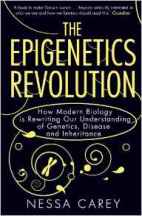Some books I’ve found helpful over the years:
The Story of the Human Body. Daniel Lieberman, Vintage Press, 2014. This is the story of how our bodies evolved, the selective pressures, adaptations and maladaptive responses. Essentially, our bodies are not perfect, never have been. But in today’s world that may be more of an issue, than it was to our hunter-gatherer ancestors.
Why We Get Sick. Randolph Nesse and George Williams. Times Books, 1994. A classic for anyone interested in evolution and medicine or Darwinian medicine. Provides an evolutionary perspective to how our bodies function, and sometimes malfunction.
Epigenetics: Linking genotype and phenotype in development and evolution. Edited by Benedikt Hallgrimsson and Brian K. Hall. viii 1 459 pp. Berkeley,CA: University of California Press. 2011. For a review see: Barry Bogin, American Journal of Human Biology (2011.)
This is an edited volume, and it is available as an ebook from University libraries. Some interesting chapters include: “A brief history of the term and concept Epigenetics” by Brian Hall; “Heuristic reductionism and the relative significance of epigenetic inheritance in evolution” by James Griesemer; and “Epigenetics : adaptation or contingency?” by Thomas Hansen.

Evolution a view form the 21st Century by James Shapiro provides a two-tiered approach to explaining what is known about genetic variation and evolution. The first few chapters and sections of chapters provide a clear enough introduction to some complicated genetics. Sharpiro’s intention is to reach both newbies like myself, and those for whom genetics is not a second (third or fourth) language. The going gets tough sometimes, but genetics and evolutionary thinking has progressed rapidly enough that it’s well worth the read even if just to get the “gist” of newer ways of thinking about evolutionary mechanisms and processes.
 Darwin in the Genome by Lynn Helena Caporale explores mechanisms of variation. Writing with . She explores the notion that variation is not dependent solely on random generation – but perhaps the generation of mutations and variation is the product of evolution as well. For a good review see: Darwin in the Genome by the National Center for Science Education.
Darwin in the Genome by Lynn Helena Caporale explores mechanisms of variation. Writing with . She explores the notion that variation is not dependent solely on random generation – but perhaps the generation of mutations and variation is the product of evolution as well. For a good review see: Darwin in the Genome by the National Center for Science Education.
Between Caporale and Shapiro’s books one gets a better feel for the incredible capacity for genetic change (both the scope and rate of change). We are not talking just a few bases here but large and broad scale changes in the genome. Add some epigenetics and it is clear that this isn’t your grandfather, or your father’s evolution! (All books provide a number of citations, along with glossaries, and basic explanations of key concepts and terms.)
 The Epigenetics Revolution by Nessa Carey provides a fascinating introduction to epigenetics, modifications that alter gene expression, without changing DNA sequencing. Carey’s subtitle says it all, “How modern biology is rewriting our understanding of genetics, disease and inheritance.” Carey explains the importance of heritable epigenetic changes (for example how a cell becomes a dedicated liver cell, or skin cell, even though each cell contains the full genetic complement, and how epigenetic changes are responsible for perpetuating each cell line,) by taking the reader on a journey through the history of each discovery. How epigenetics might influence evolution is anyone’s guess (and Carey does not venture into this territory, but the book is well worth reading.)
The Epigenetics Revolution by Nessa Carey provides a fascinating introduction to epigenetics, modifications that alter gene expression, without changing DNA sequencing. Carey’s subtitle says it all, “How modern biology is rewriting our understanding of genetics, disease and inheritance.” Carey explains the importance of heritable epigenetic changes (for example how a cell becomes a dedicated liver cell, or skin cell, even though each cell contains the full genetic complement, and how epigenetic changes are responsible for perpetuating each cell line,) by taking the reader on a journey through the history of each discovery. How epigenetics might influence evolution is anyone’s guess (and Carey does not venture into this territory, but the book is well worth reading.)
 The Evolution Explosion: how humans cause rapid evolutionary change by Stephen R. Palumbi published in 2001, is one of the first books focused on our role in rapid or contemporary evolution. Palumbi’s clear writing introduces the reader to the basics of evolution, followed by examples of rapid evolution including antibiotic resistance, the evolution of HIV, biotechnology, evolution in response to fishing pressures even the evolution if idea.
The Evolution Explosion: how humans cause rapid evolutionary change by Stephen R. Palumbi published in 2001, is one of the first books focused on our role in rapid or contemporary evolution. Palumbi’s clear writing introduces the reader to the basics of evolution, followed by examples of rapid evolution including antibiotic resistance, the evolution of HIV, biotechnology, evolution in response to fishing pressures even the evolution if idea.
 If you are looking for a review of the medical events and outbreaks cause by rapid evolution as a result antibiotics, Superbug is a good place to begin. Maryn McKenna follows MRSA from its emergence in hospitals to it’s unlikely emergence in the community, an event that was at first greeted with skepticism — a resistant strain in the hospital was almost to be expected. But was it possible that resistant strains could evolve and spread within the larger community? Of course we now know the answer is yes. Sometimes a difficult and heartbreaking read, McKenna’s book provides insight into the human cost of antibiotic infection. I include this here because antibiotic resistance is one of the most immediate and important effects of rapid evolution and we are the most important sources of selective pressure
If you are looking for a review of the medical events and outbreaks cause by rapid evolution as a result antibiotics, Superbug is a good place to begin. Maryn McKenna follows MRSA from its emergence in hospitals to it’s unlikely emergence in the community, an event that was at first greeted with skepticism — a resistant strain in the hospital was almost to be expected. But was it possible that resistant strains could evolve and spread within the larger community? Of course we now know the answer is yes. Sometimes a difficult and heartbreaking read, McKenna’s book provides insight into the human cost of antibiotic infection. I include this here because antibiotic resistance is one of the most immediate and important effects of rapid evolution and we are the most important sources of selective pressure
.
